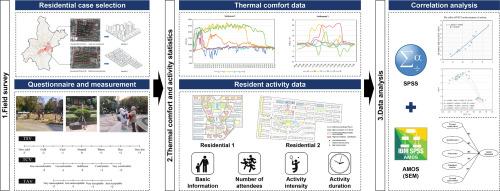空间形态和热舒适对居住区步行活动的协同效应——基于武汉的实地研究
IF 7.6
1区 工程技术
Q1 CONSTRUCTION & BUILDING TECHNOLOGY
引用次数: 0
摘要
空间形态与环境舒适度的相互作用对户外出勤率和行为活动均有显著影响。然而,有限的研究清楚地阐明了室外空间形态、热舒适和空间活力之间的相互关系。本研究旨在探讨室外空间形态和热舒适对行人活动的协同影响机制,以预测不同公共空间的使用模式。通过夏季和冬季6天的野外测量,获得了覆盖小气候、热感觉和室外活动的综合数据集。通过引入结构方程模型(SEM),确定了空间、环境和行为因素对空间活力的影响路径。结果表明:①武汉市居民室外有效热舒适温度范围为7.77 ~ 36.87℃,普遍热气候指数(UTCI)约为22.33℃时达到舒适峰值;(2)冬季户外活动高峰在上午11点和下午4点左右;在夏季,高峰发生在上午10点之前和下午4点之后。空间连通性、可达性和天空景观因子是影响活力的关键空间因子(因子负荷分别为0.84、0.71和0.80)。热舒适是最重要的热感知变量(负荷= 0.65),而年龄是最重要的个体因素(负荷= 0.85)。(3)空间开放度越高,居民的环境敏感性越高,UTCI-activity关系越陡峭、越准确。该研究量化了空间形态、室外环境和人口特征如何塑造空间活力,为优化住宅室外空间设计提供指导。本文章由计算机程序翻译,如有差异,请以英文原文为准。

Synergistic effects of spatial morphology and thermal comfort on pedestrian activities in residential areas: A field-based study in Wuhan, China
Both outdoor attendance and behavioral activities are significantly affected by the interplay between spatial morphology and environmental comfort. However, limited research has clearly elucidated the interrelationship among outdoor spatial morphology, thermal comfort, and spatial vitality. The aim of the study was to explore the synergistic influence mechanism of outdoor spatial morphology and thermal comfort on pedestrian activities to predict the usage patterns of different communal spaces. A comprehensive dataset covering microclimate, thermal sensation, and outdoor activities was obtained through field measurements over six typical days in both summer and winter. By introducing structural equation modeling (SEM), this study identified the influence paths by which spatial, environmental, and behavioral factors affect spatial vitality. The results indicate that: (1) The effective outdoor thermal comfort temperature range for Wuhan residents is between 7.77 °C and 36.87 °C, with peak comfort occurring at a Universal Thermal Climate Index (UTCI) of approximately 22.33 °C. (2) In winter, outdoor activities peak around 11:00 a.m. and 4:00 pm.; in summer, peaks occur before 10:00 a.m. and after 4:00 pm. Spatial connectivity, accessibility, and sky view factor were key spatial factors influencing vitality (factor loadings: 0.84, 0.71, and 0.80). Thermal comfort was the most influential thermal perception variable (loading = 0.65), while age was the most significant individual factor (loading = 0.85). (3) Greater spatial openness enhances residents’ environmental sensitivity, with steeper and more accurate UTCI–activity relationships. This study quantifies how spatial morphology, outdoor environment, and demographics shape spatial vitality, offering guidance for optimizing residential outdoor space design.
求助全文
通过发布文献求助,成功后即可免费获取论文全文。
去求助
来源期刊

Building and Environment
工程技术-工程:环境
CiteScore
12.50
自引率
23.00%
发文量
1130
审稿时长
27 days
期刊介绍:
Building and Environment, an international journal, is dedicated to publishing original research papers, comprehensive review articles, editorials, and short communications in the fields of building science, urban physics, and human interaction with the indoor and outdoor built environment. The journal emphasizes innovative technologies and knowledge verified through measurement and analysis. It covers environmental performance across various spatial scales, from cities and communities to buildings and systems, fostering collaborative, multi-disciplinary research with broader significance.
 求助内容:
求助内容: 应助结果提醒方式:
应助结果提醒方式:


